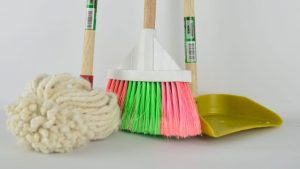A graphic photo in The Hindu recently inspired this two part blog post.
As we walk around Chennai, we often have to navigate mounds of garbage. Garbage has a mysterious way of reappearing in double its size after it has been hauled away just a night before, and I cannot help being intrigued by the contents of trash.
Even protected areas like the bio-diverse IIT Madras campus suffer from the garbage problem. A week back on one of our now frequent walks in the IIT campus, Srini and I came across a couple of beautiful spotted deer busily nosing around old discarded containers of junk food. As we gently chased away the deer (who looked most grieved) and safely disposed the junk food container; we began talking about Chennai’s trash cans, and what ails them.

Some digging (this time on the internet) threw up very interesting facts and figures.
There are many ways to look at the trash data. The simplest – how much trash (or solid waste) does each country generate on an average?
It comes as no surprise that the average US citizen is nearly at the head of the pack; trashing nearly 2 Kg of solid waste every day compared to urban Indians who generate 600 grams of waste every day.
Before we begin to pat ourselves on the back, consider this: In just the last 10 years Indians have doubled their trash generation from 34 million tonnes per year to 68 million tons per year.
Which lead me to the question; just what are we, the urban Indians, throwing out of our homes?
All of us, no matter where we live, generate 4 categories of trash
- Compostable waste – Organic food peels, trimmings, dried leaves, leftover food, etc that can be composted to give rich , nutritious soil
- Re-cyclable waste – Paper, plastic packaging, glass, metals, aluminium foil, etc which, if cleaned and processed properly could be re-used. Certain materials like aluminium foil have a 95% recovery / recycling rate if cleaned properly. Recyclable waste is a category that is only potentially recyclable – by mixing them with other kinds of waste, it makes them difficult to separate, clean and process to re-use.
- Partially recyclable / re-coverable waste – Most of the E-waste we generate from chargers, to used batteries and other electronic goods falls into this category. If separated and recycled properly, a small –moderate portion of the raw materials that go into the making of these goods can be recovered like metals and precious metals. However, the portion of material that can be recovered is small, the process is potentially toxic and hazardous, and the balance of the material goes waste.
- Re-usable material – Due to rapid urbanisation, every city in India is now in the midst of a construction spree. All the construction debris that is generated (sand, cement, iron and steel girders bricks) if stored separately can be re-used in other construction activity.
Every country today has a problem of excess trash – we have run out of space to store our garbage, and cannot get rid of it in any safe, non-toxic way. Different countries depending on the composition of their solid waste have different strategies to tackle the problem.
A Comparison of Solid waste composition between the US & India:
The U.S. generates the highest volume of solid waste in the world and the highest per capita waste in the world. But because of the nature of waste they generate, they also have a high level of efficiency in their waste reduction programmes.

The solid waste composition of each household is very high in recyclable waste like paper and plastic packaging. While U.S. per capita waste per year has increased, the recycling rate has also increased.
Handling food waste in the U.S. still remains an issue – a very small percent of it is currently being composted.
Urban India presents a very different picture:

The biggest portion of India’s waste is actually compostable material, followed by re-usable material.
The addition of food waste makes the solid waste we generate messy and problematic. Most food waste contains a lot of moisture, which makes other materials like paper and plastic less recyclable.
Composting does take place in India at the Municipal corporation level, but only 3% of the organic matter generated by us is composted formally.
Of this percentage which is composted, most of the organic matter had not been separated from the debris and recyclable material, bringing down the effectiveness of compost – As a result of lack of source segregation, of the 3% of the organic material that is composted, only 7%of this is converted into compost – which is a shockingly low 0.21% of all waste generated.
Further, this measly 0.21% compost, because of the lack of source segregation, it is often found to be high in heavy metals, making it unusable for agriculture.
So what happens, you may ask, to the waste now that it is not composted, or segregated?
Most of our urban waste goes to landfills such as these where it just sits there for eternity, or gets burned, leading to a high amount of pollution generated and lethal toxins released into the air.

In Chennai, every single person is responsible for nearly 200 Kg of solid waste per year, which in turn ends up in the landfills which use up 550 acres in Chennai. The Chennai Corporation estimates that if we do not change our ways, these 550 acres will get exhausted by 2015. To put this in perspective, this landfill is roughly the size of the IIT madras campus, piled high with waste!
The Solutions
At the end of this rather long discussion, it can be exhausting to contemplate the magnitude of the problem before us, but there is good news.
As mentioned earlier, In the US, the EPA has managed to take back nearly 34% of re-cyclable paper and plastic from their landfills. This requires diligent recycling of paper and plastic by the citizens.
We too can help make a solid difference in India, by examining and changing our behaviour.
A. Reducing organic waste : reduce what gets thrown out
The rather massive quantity of food waste that is getting thrown out in India today suggests two issues:
1) We seem to be buying more food / vegetables / fruits than we can consume and
2) We are throwing away the stuff that rots / what we cannot eat.
So the first step to reducing the landfill mess is to be careful about estimating and buying the food you need.
Having analysed my garbage, I have concluded that one of the big problems in our home is over buying and improper storage. Frequent power outages are causing the food in the fridge to rot faster and I am forced to throw away a portion of my fruits and vegetables without eating them.
Since we only buy organic fruits and vegetables, which are not so readily available, I buy them in bulk once a week. This sometimes leads to excess buying and I am now trying hard to estimate exactly what I need, and avoid wastage.
B. Reducing organic waste: over processing of fresh food
The other often ignored part in food waste over processing. When you eat food whole, no trimmings go to the landfill. For e.g.: the head of the tomato is often sliced out for aesthetic reasons and discarded – you lose out on both nutrition and contribute to a landfill. At my home, I eat the leaves of carrots and beets and most other vegetables too, stalk and all – brilliant nutrition and landfill saved.
Here are some examples of trimmings that you could eat instead of discarding: peels (carrots, potatoes, bottle gourd, cucumber), stalks and greens (carrots, beets), heads (tomatoes, bottle gourd) .
C. Source Segregation : Separating waste into compostable /recyclable / re-usable
The default option in Indian homes today is a single kitchen waste bin in which all biodegradable and non biodegradable waste get mixed together and thrown out.
Biodegradable waste like fruit and vegetable trimmings and other food scraps have high moisture content. When this is mixed with re-usable or recyclable waste like paper or plastic, it makes them wet and soggy, therefore unfit for reusing or recycling.

Paper and plastic must be sorted and kept aside either to be recycled along with your Municipal collector or can be given to the raddiwala. Every single piece of plastic that enters your home can be recycled or re-used. If the plastic that comes in contact with food or cosmetics should be rinsed and washed thoroughly and dried to ensure that they will be recycled.

D. Home Composting
After source segregation, composting your organic waste yourself is a massive game changing step that you can take to make a serious dent on the landfill problem.
There are excellent organisations like daily Dump who have created easy to use, compact personal composters which can be used to create healthy plant food from all the previously discarded organic matter.
Here is a picture from Vani Murthy’s kambha at Bangalore, where she “makes” excellent, nutritious plant food, from organic waste which would have otherwise gone to a landfill.

This concludes Part 1 of this post. E-waste is another critical issue which is the subject of Part 2.
Sources, Resources, & People who can help:
Thank you to:
- Ranjith Kharvel Annepu of Columbia University for the meticulous report on Solid waste management in India created as a result of 2 years of research, data collected through literature, expert consultations and extensive field visits covering 13 cities in India. Ranjith has been very generous in sharing his data and report with me.
- ExNoRa for the extensive photographic coverage of the solid waste issues that exist in Indian cities through their initiative www.garbo.in – do visit, it is an eye opener
- Archana Srinivas – wielder of the magic camera, discoverer of all things beautiful and aesthetic on her blog rang decor, and a committed composter and recycler for being generous with her pictures and information on composting and recycling. To view her complete set of pictures on home composting, please visit: http://www.flickr.com/photos/archanasr_2000/sets/72157627556458791/
- Vani Murthy – the Composting Queen who inspires Malleswaram and everyone outside of it to segregate their waste and create wonderful plant food using the Kambha. It is rare to come across people like Vani who literally take to the street inspiring and educating people on solid waste management. Vani ,again, has been extraordinarily generous with her knowledge and her pictures for this post: To know more about how you can compost at home, please go through Vani’s step by step guide here: https://picasaweb.google.com/110138724722809258966/JourneyOfMyKitchenWaste and
https://picasaweb.google.com/106938949057966909183/LeafCompostingInMyBackYard







Would jus like to share….Ive herad that the top part of the tomato The green nerve like part is carcinogenic….so ppl at my home always discard it ,one could dispose only that part insted of cutting the tomato head totally!!!